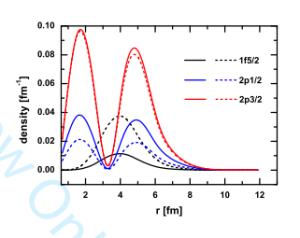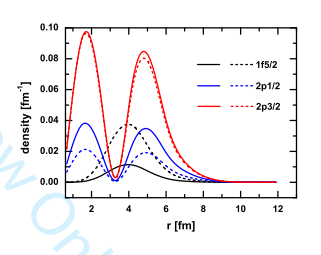|
[1]
|
Isao Tanihata, Herve Savajols, and Rituparna Kanungo, Prog. Part. Nucl. Phys., 68:215-313(2013) |
|
[2]
|
J. Meng and S. G. Zhou, J. Phys. G, 42(9):093101(2015) |
|
[3]
|
J. Dobaczewski, W. Nazarewicz, T. R. Werner, J. F. Berger, C. R. Chinn, and J. Decharge, Phys. Rev. C, 53:2809-2840(1996) |
|
[4]
|
J. Meng and P. Ring, Phys. Rev. Lett., 77:3963-3966(1996) |
|
[5]
|
W. Poschl, D. Vretenar, G. A. Lalazissis, and P. Ring, Phys. Rev. Lett., 79:3841-3844(1997) |
|
[6]
|
G. A. Lalazissis, D. Vretenar, W. Poeschl, and P. Ring, Phys. Lett. B, 418:7-12(1998) |
|
[7]
|
Jie Meng, Nucl. Phys. A, 635(1-2):3-42(1998) |
|
[8]
|
N. Sandulescu, Nguyen Van Giai, and R. J. Liotta, Phys. Rev. C, 61:061301(2000) |
|
[9]
|
Li-Gang Cao and Zhong-Yu Ma, Phys. Rev. C, 66:024311(2002) |
|
[10]
|
N. Sandulescu, L. S. Geng, H. Toki, and G. C. Hillhouse, Phys. Rev. C, 68:054323(2003) |
|
[11]
|
Li-Sheng Geng, Hiroshi Toki, Satoru Sugimoto, and Jie Meng, Prog. Theor. Phys., 110:921-936(2003) |
|
[12]
|
J. C. Pei, A. T. Kruppa, and W. Nazarewicz, Phys. Rev. C, 84:024311(2011) |
|
[13]
|
Shi-Sheng Zhang, En-Guang Zhao, and Shan-Gui Zhou, Eur. Phys. J. A, 49(6):77(2013) |
|
[14]
|
Ya-Juan Tian, Tai-Hua Heng, Zhong-Ming Niu, Quan Liu, and Jian-You Guo, Chin. Phys. C, 41(4):044104(2017) |
|
[15]
|
P. Ring and P. Schuck, The Nuclear Many-Body Problem, (New York:Springer-Verlag, 1980) |
|
[16]
|
A.Bohr and B. R. Mottelson, Nuclear Structure, (Singapore:World Scientific, 1998) |
|
[17]
|
John Bardeen, L. N. Cooper, and J. R. Schrieffer, Phys. Rev., 106:162(1957) |
|
[18]
|
John Bardeen, L. N. Cooper, and J. R. Schrieffer, Phys. Rev., 108:1175-1204(1957) |
|
[19]
|
Leon N Cooper et al, BCS:50 years, (World Scientific, 2011) |
|
[20]
|
N. N. Bogolyubov, Sov. Phys. JETP, 7:41-46(1958);[Front. Phys., 6:399(1961)] |
|
[21]
|
Klaus Dietrich, Hans J. Mang, and Jean H. Pradal, Phys. Rev., 135:B22-B34(1964) |
|
[22]
|
D. J. Dean and M. Hjorth-Jensen, Rev. Mod. Phys., 75:607-656(2003) |
|
[23]
|
Javid A. Sheikh and Peter Ring, Nucl. Phys. A, 665(1-2):71-91(2000) |
|
[24]
|
J. A. Sheikh, P. Ring, E. Lopes, and R. Rossignoli, Phys. Rev. C, 66:044318(2002) |
|
[25]
|
M. Anguiano, J. L. Egido, and L. M. Robledo, Nucl. Phys. A, 696(3-4):467-493(2001) |
|
[26]
|
M. Anguiano, J. L. Egido, and L. M. Robledo, Phys. Lett. B, 545:62-72(2002) |
|
[27]
|
Michael Bender, Paul-Henri Heenen, and Paul-Gerhard Reinhard, Rev. Mod. Phys., 75:121-180(2003) |
|
[28]
|
T. Nikić, D. Vretenar, and P. Ring, Phys. Rev. C, 73:034308 (2006) |
|
[29]
|
T. Nikić, D. Vretenar, and P. Ring, Phys. Rev. C, 74:064309 (2006) |
|
[30]
|
Wei-Chia Chen, J. Piekarewicz, and A. Volya, Phys. Rev. C, 89(1):014321(2014) |
|
[31]
|
Jie Meng, Jian-You Guo, Lang Liu, and Shuang-Quan Zhang, Front. Phys. China, 1:38(2006) |
|
[32]
|
Ming-Jian Cheng, Lang Liu, and Yi-Xin Zhang, Chin. Phys. C, 39(10):104102(2015) |
|
[33]
|
Z. Shi, Z. H. Zhang, Q. B. Chen, S. Q. Zhang, and J. Meng, Phys. Rev. C, 97:034317(2018) |
|
[34]
|
J. D. Walecka, Ann. Phys., 83:491-529(1974) |
|
[35]
|
P. G. Reinhard. Rept. Prog. Phys., 52:439(1989) |
|
[36]
|
Brian D. Serot and John Dirk Walecka, Adv. Nucl. Phys., 16:1-327(1986) |
|
[37]
|
P. Ring, Prog. Part. Nucl. Phys., 37:193-263(1996) |
|
[38]
|
J. Meng, H. Toki, S. G. Zhou, S. Q. Zhang, W. H. Long, and L. S. Geng, Prog. Part. Nucl. Phys., 57:470-563(2006) |
|
[39]
|
D. Vretenar, A. V. Afanasjev, G. A. Lalazissis, and P. Ring, Phys. Rept., 409:101-259(2005) |
|
[40]
|
J. Meng, Relativistic density functional for nuclear structure, volume 10, (World Scientific, 2016) |
|
[41]
|
Y. K. Gambhir, P. Ring, and A. Thimet, Annals Phys., 198:132-179(1990) |
|
[42]
|
P. Ring, Y. K. Gambhir, and G. A. Lalazissis, Comput. Phys. Commun., 105:77-97(1997) |
|
[43]
|
G. A. Lalazissis, J. Knig, and P. Ring, Phys. Rev. C, 55:540-543(1997) |
|
[44]
|
Y. Sugahara and H. Toki, Nucl. Phys. A, 579(3):557-572(1994) |
|
[45]
|
Wen-Hui Long, Jie Meng, Nguyen Van Giai, and Shan-Gui Zhou, Phys. Rev. C, 69:034319(2004) |
|
[46]
|
Chin W. Ma and John O. Rasmussen, Phys. Rev. C, 16:1179-1195(1977) |
|
[47]
|
A. Gade et al, Phys. Rev. C, 74:021302(2006) |
|
[48]
|
F. Wienholtz et al, Nature, 498(7454):346-349(2013) |
|
[49]
|
Marcella Grasso, Phys. Rev. C, 89:034316(2014) |
|
[50]
|
Jia Jie Li, Jr?me Margueron, Wen Hui Long, and Nguyen Van Giai, Phys. Lett. B, 753:97-102(2016) |
|
[51]
|
W. J. Huang, G. Audi, Meng Wang, F. G. Kondev, S. Naimi, and Xing Xu, Chin. phys. C, 41(3):30002(2017) |
|
[52]
|
Nobuo Hinohara and Witold Nazarewicz, theory. Phys. Rev. Lett., 116:152502(2016) |
|
[53]
|
D. Lunney, J. M. Pearson, and C. Thibault, Rev. Mod. Phys., 75:1021-1082(2003) |
|
[54]
|
P. H. Heenen, A. Valor, M. Bender, P. Bonche, and H. Flocard, Eur. Phys. J. A, 11:393-402(2001) |
|
[55]
|
Shan-Gui Zhou, Jie Meng, and P. Ring, Phys. Rev. C, 68:034323(2003) |
|
[56]
|
Shan-Gui Zhou, Jie Meng, P. Ring, and En-Guang Zhao, Phys. Rev. C, 82:011301(2010) |





 Abstract
Abstract HTML
HTML Reference
Reference Related
Related PDF
PDF














 DownLoad:
DownLoad:
